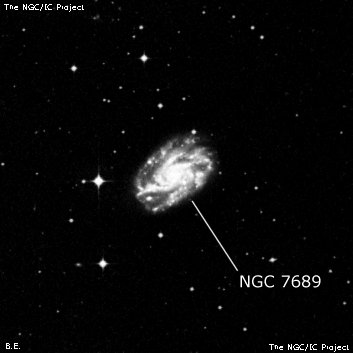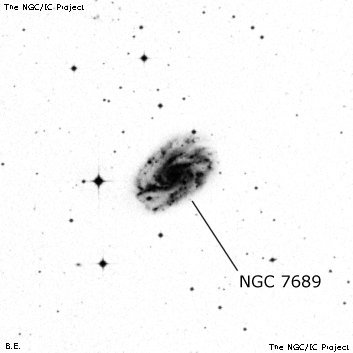NGC/IC Project Restoration Effort
(This is a very very beta version)
NGC7689


Basic Information
Location and Magnitude
Right Ascension: 23:33:16.4
Declination: -54:5:39
Constellation: PHE
Visual Magnitude: 11.5
Historic Information
Discoverer: Dunlop
Year of discovery: 1826
Discovery aperture: 9.0
Observational
Summary description: pF, L, R, vgbM
Sub-type: SBc
Corwin's Notes
=====
NGC 7689. The RC3 position (from ESO) is correct (barring an error in ESO,
of course), while RC2 gives the wrong RA. Oddly, there is nothing in the GSC
at either position, though ESO-LV repeats the ESO position and gives plausible
data for the galaxy there.
-----
The incorrect RA in RC2 is from the NGC, GC, and finally JH whose RA is just
30 seconds too small. While I haven't yet looked at the sweep, I don't think
that this can be wire error -- at this declination, the minimum wire error
would be 48 seconds. So, it looks to be a simple digit error somewhere in the
observation/reduction "pipeline".
The surface brightness of the galaxy is apparently a bit too low for the GSC,
by the way. The object itself is a beautiful SB(sr)bc I-II spiral, and has
entries in the 2MASS lists, UCAC, GSC3, and UB10. I've adopted the position
from 2MASS PSC.
Steve's Notes
=====
NGC 7689
30" (10/13/15 - OzSky): at 303; bright, very large, oval 3:2 or 5:3 NW-SE, ~2.7'x1.8', contains a relatively large brighter core that is only weakly concentrated. Spiral structure is evident. A short arm is attached on the southeast side of the core and extends east. A second arm appears to be attached on the southwest side of the core and extends southeast. Finally a third arm appears to the north of the core. The halo is patchy or mottled on the northwest side (HII regions or parts of an arm). A mag 11 star is 2.2' E of center, a mag 15 star is at the north-northwest edge of the halo and a mag 16 star (or stellar knot) is at the northeast edge of the halo.



